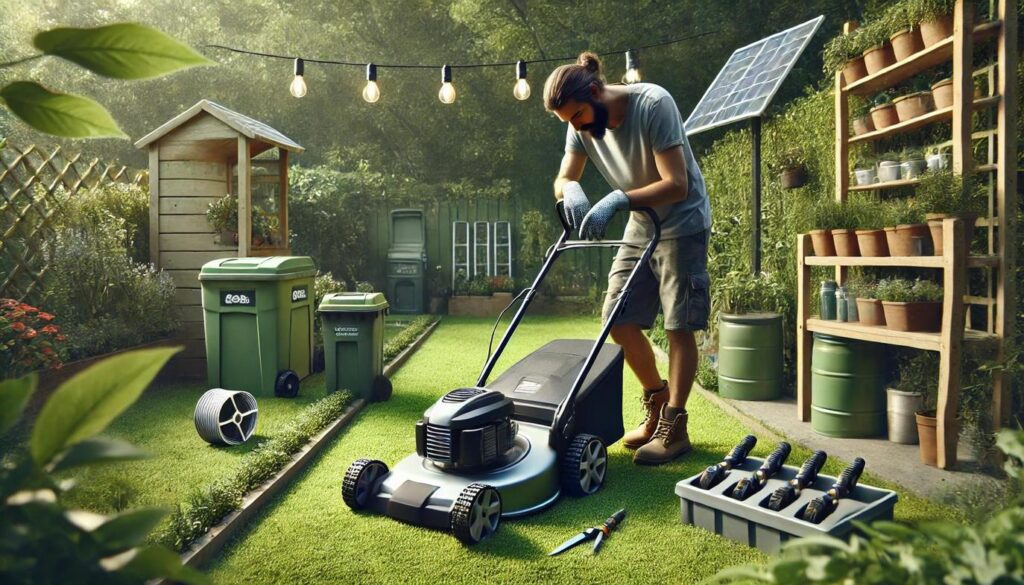Have you ever considered the carbon footprint of your iPhone? Every product we buy leaves a trail of CO₂ behind, and smartphones are no exception. Mining the raw materials, shipping phones worldwide, stocking them in stores, powering them during daily use, and eventually recycling or trashing them — all of it adds up. That means the carbon bill isn’t just Apple’s problem; it’s ours, too.
In this article, we break down the iPhone’s carbon footprint — what it is, how big it is, and how regular users can help reduce it. Are you prepared to explore further? Let’s break it down together.
Breakdown of the iPhone’s Emissions and Lifecycle Impact
First things first — what’s a carbon footprint, anyway? It’s the total amount of greenhouse gases a product pumps into the atmosphere from start to finish, all rolled up into one number called CO₂-equivalent (CO₂e). The higher that number, the bigger the product’s share of global warming.
Every year, Apple publishes a Product Environmental Report that outlines the amount of CO₂e each new iPhone emits into the atmosphere. The iPhone 16 clocks in at about 56 kg CO₂e over its lifetime. Here’s where that carbon comes from:
- Production (about 80 %): Most of the emissions happen before the phone even lands in your hands. Think of everything that goes into making it: fabricating the A-series chip, growing the display, building the battery, and then piecing it all together on the assembly line. Manufacturing consumes the most energy and resources, resulting in the largest share of the carbon footprint.
- Everyday use (18%): About a fifth of the phone’s lifetime emissions come from the electricity you burn while charging it.
- Getting it to you (3%): Shipping the finished phones from the factory to distribution centers, stores, and, finally, your front door adds only a few kilos of CO₂e. Bulk ocean freight and other efficient logistics keep this number surprisingly low.
- End‑of‑life recycling (<1%): When the phone finally calls it quits, properly recycling it generates a tiny bit of carbon. Still, it’s worth doing — recovering metals helps avoid the need to mine new materials in future production.
Keep in mind that the carbon footprint of an iPhone changes with the model and its storage size. For example, the iPhone 16 with a 512 GB footprint climbs to roughly 74 kg CO₂e — extra capacity means extra materials and energy.
Let’s put that into perspective: Compare that to a typical gas car, which kicks out about 4.6 metric tons (4,600 kg) of CO₂e a year if you drive 12,000 miles at 25 mpg. Stack the numbers, and you’d need around 82 iPhones to match just one year of emissions from a single car.
Even though one iPhone’s carbon footprint looks small next to a car’s, the global impact adds up fast. Apple sells over 200 million iPhones a year. Multiply that by the footprint of a single device, and suddenly that “small” number turns into a major environmental impact.
How Apple Reduces the iPhone’s Carbon Footprint
Apple’s commitment to sustainability is evident in its ambitious Apple 2030 plan, which aims to reduce the company’s entire carbon footprint, including product life cycles and supply chains, to net zero. Apple isn’t just talking about climate action — it’s backing it up with real results.
In its 2024 Product Environmental Report, the company calls out two big wins for the iPhone 16 line:
In its 2024 Product Environmental Report, the company calls out two big wins for the iPhone 16 line
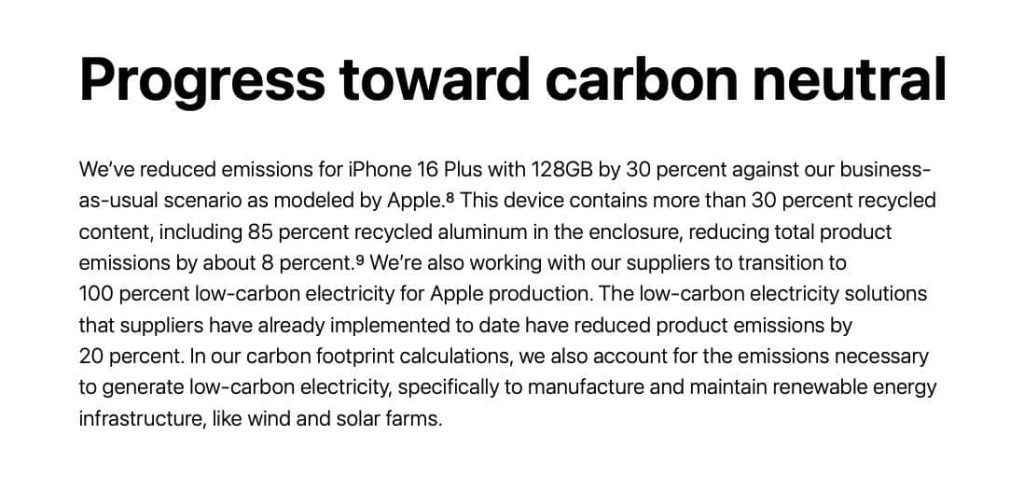
- Over 30 percent of each phone now comes from recycled materials, which slashes the need to dig up and process fresh resources.
- More than 30 percent of the electricity used to build every iPhone 16 comes from renewable sources, thanks to new deals with suppliers. That’s a serious upgrade for both Apple’s factories and the tech industry’s sustainability game.
Alongside its broader sustainability goals, Apple has rolled out a few targeted practices to help cut emissions:
- iPhones often use enclosures made from recycled aluminum. It’s not just eco-friendly — it also helps lower the carbon output tied to mining and producing new materials.
- Apple ditched the plastic-heavy boxes — almost all of the packaging is now paper, which is easier to recycle and friendlier to the planet.
- And when your device has run its course, Apple’s trade‑in program gives it a second life by refurbishing or responsibly recycling it. That keeps old gear out of landfills and cuts down on the raw materials needed for brand‑new devices.
How to Reduce Your iPhone’s Environmental Impact
Apple’s doing its part to shrink the iPhone’s environmental impact, but what about us? It turns out that we can also contribute to reducing the environmental impact of the iPhone. About 18% of an iPhone’s lifetime emissions come from the electricity we use to charge it. That may sound small next to the 80% baked in at the factory. But multiply that by hundreds of millions of users, and it adds up fast. If each of us gets a little smarter about how and when we plug in, the collective result could be huge.
Next, we’ll walk through a few simple moves that can reduce the iPhone’s carbon footprint from charging.
1.Charge Your Phone When Necessary
Only plug in your iPhone when it really needs a charge —don’t leave it on the charger when it’s already at 99%. Also, try not to leave it connected for hours. Both habits waste power and can shorten your battery’s life.
To extend your iPhone’s battery life between charges, enable Low Power Mode. It scales back background refresh, dims the screen a bit, and tones down animations. Your phone may feel a tad slower, but you’ll plug in a lot less, saving both battery and energy.
- Tap the Settings icon on your iPhone’s home screen.
- Scroll down and tap Battery.
- Toggle on Low Power Mode. When it’s active, the battery icon turns yellow, so you’ll know it’s on.
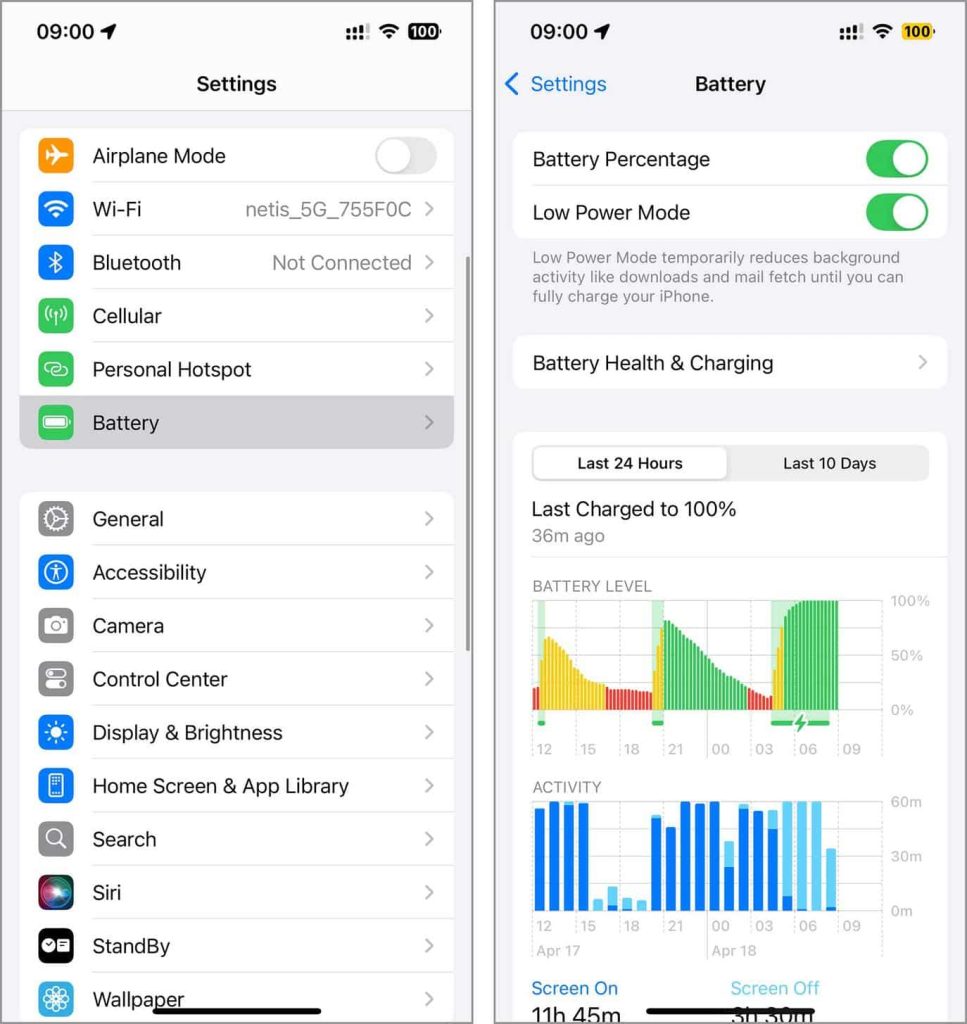
Another easy way to extend your battery life (and reduce the need to plug in) is to adjust the Background App Refresh setting. Most apps check for new updates even when you’re not using them, which quietly consumes power. Turn that constant updating off or limit it to Wi‑Fi, and apps will grab fresh data only when you open them. Less behind-the-scenes activity means a battery that lasts longer and fewer charger uses.
1.Tap the Settings icon on your home screen, scroll down, and tap General.
2.Then select Background App Refresh.
3.You’ll see three options:
- Off: completely disables background activity for all apps. This saves the most battery.
- Wi-Fi: It lets apps refresh only when you’re on Wi-Fi. Suitable for saving both battery and cellular data
- Wi-Fi & Cellular Data: allows full background activity. This option uses the most energy and data, making it the least efficient choice.
4.Select the one that works best for your phone usage.
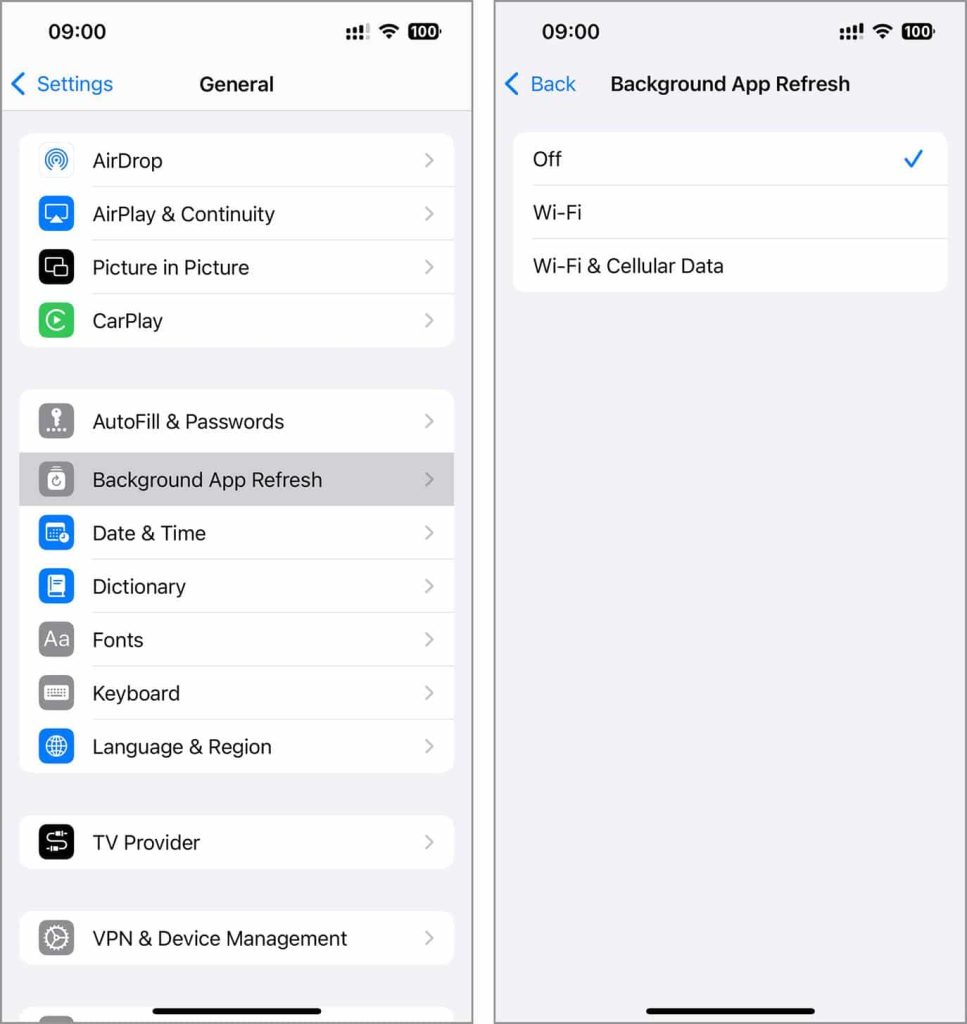
To lower the carbon footprint from charging your iPhone, consider using an ENERGY STAR-certified or high-efficiency charger. High-efficiency models draw less power from the wall and convert more of it into battery power, rather than wasting energy. Hunt for chargers with energy-saving modes or an ENERGY STAR badge. They’ll cut your electricity use and make your daily charging routine a little greener.
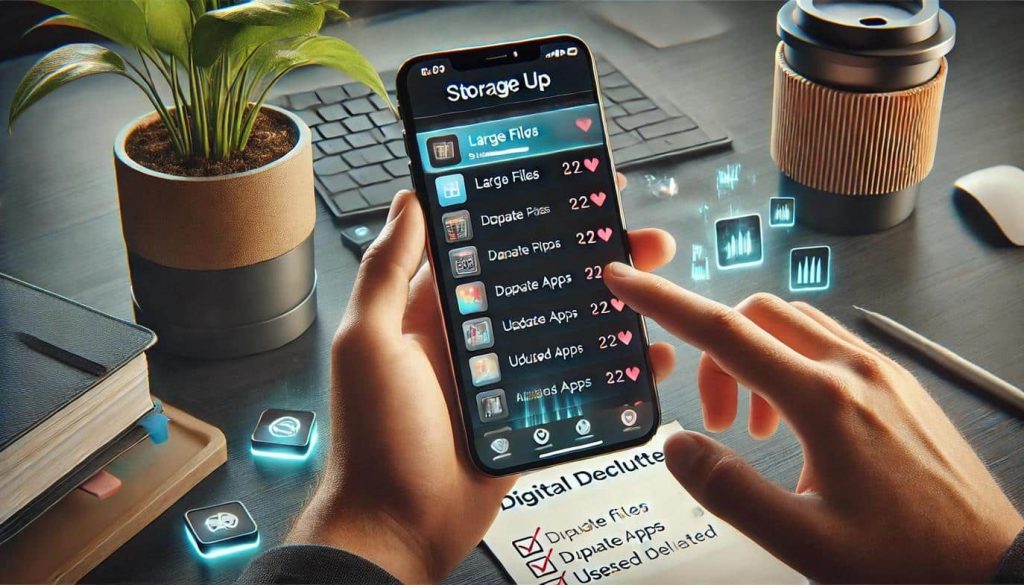
2.Clean Up Your iPhone Storage
You might not realize it, but the number of files stored on your iPhone can actually impact your battery life, which in turn contributes to your carbon footprint. When your iPhone storage is full, your device has to work harder to process everything, which drains the battery faster.
The easiest way to fix that? Start by clearing out the elements you don’t need. There are several ways to free up space on your iPhone, but in this section, we’ll focus on the Photos app and third-party apps, as they tend to consume the most storage. That’s not just our opinion — Reddit users say the same.
Photo Gallery Cleanup Tips
Manually browsing through your photo gallery can be time-consuming. A faster and more efficient option is to use an iPhone cleaning app. These apps scan your Photos library and quickly flag duplicates, similar shots, screenshots, and large videos, cutting the cleanup time down to just a few minutes.
The usage flow is basically the same, no matter which one you choose from the App Store: grant photo access, wait for the scan, review the results, and hit delete. Most options hide the good features behind a paywall (usually after a 3‑ to 7‑day trial), but Clever Cleaner stays free if you want to test‑drive a no‑cost solution.
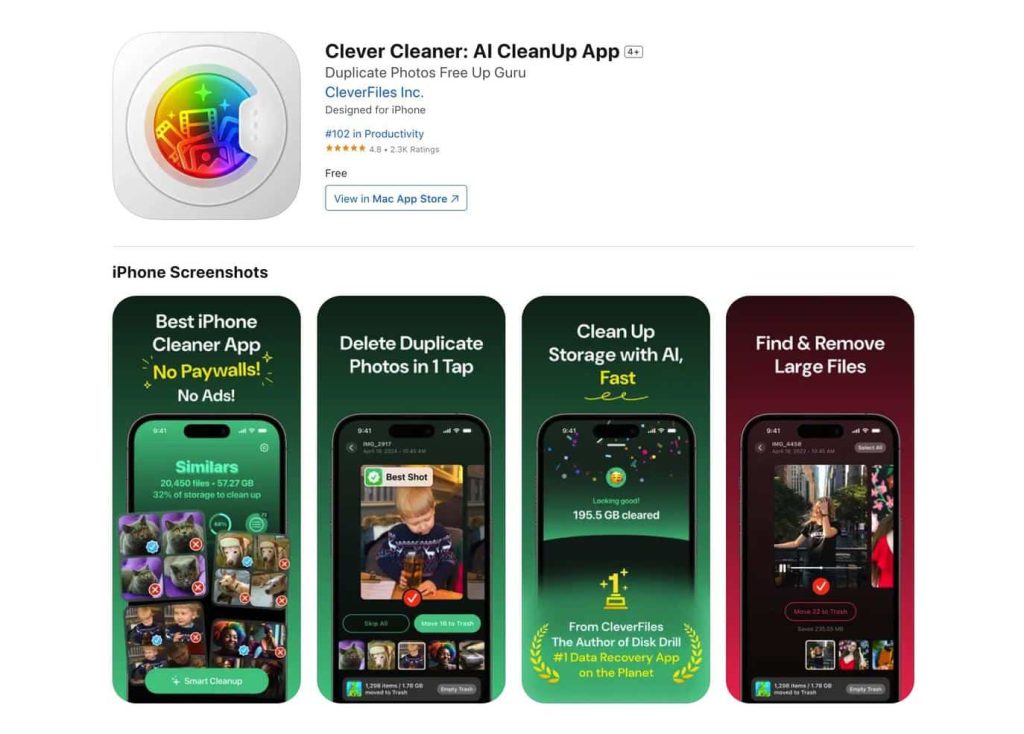
Managing App Storage and Battery Drain
When it comes to apps, a lot of them build up extra data over time. What starts as a 200MB download can quickly grow to several gigabytes due to cached data, updates, and usage logs. Some apps allow you to clear this data in their settings, but this option is rare. A faster solution is to simply reinstall the app — it will clear everything. Alternatively, if you no longer need the app, feel free to delete it completely.
- Tap the Settings icon on your home screen.
- Scroll down and tap General.
- Select iPhone Storage to see a list of apps and how much space each one uses.
- Find the app you want to remove and tap it.
- Tap Delete App to uninstall it and erase all its data from your iPhone.
- If you want it back, open the App Store, search for the app, and tap the download icon to reinstall it.
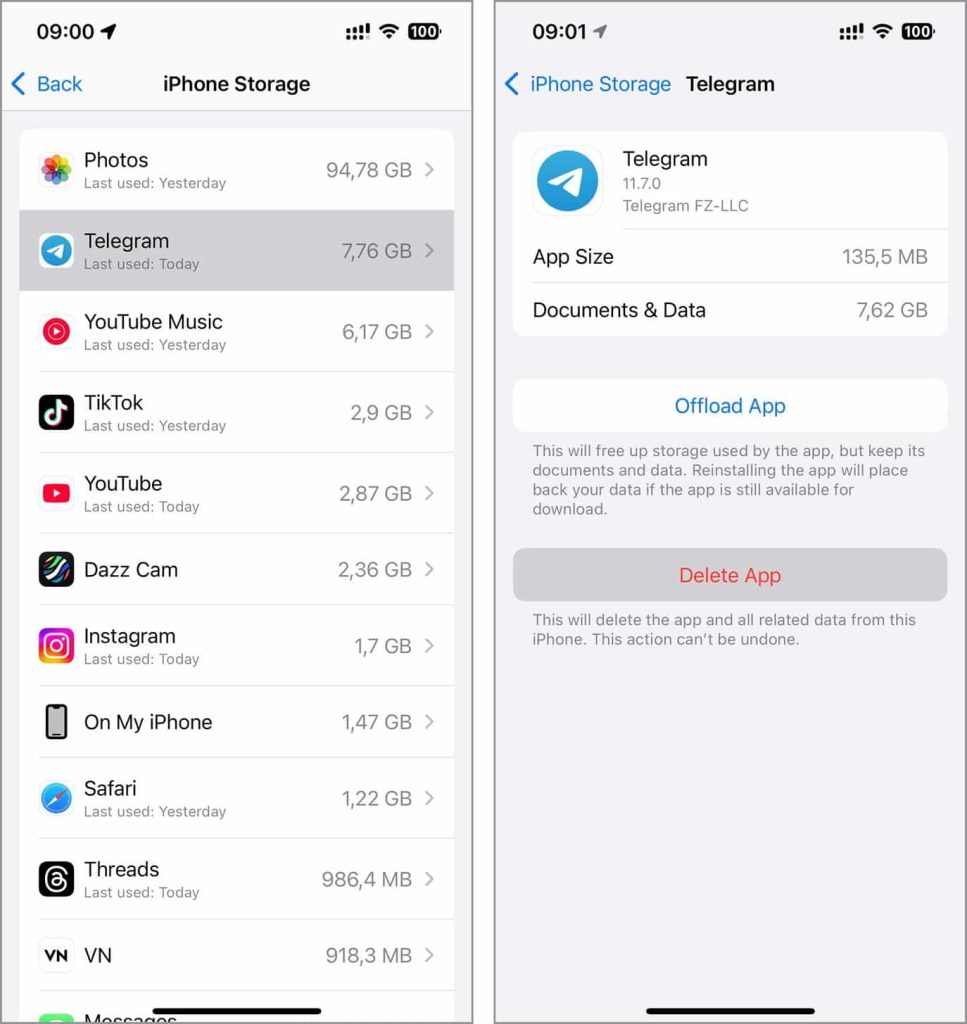
Conclusion: Reducing Your iPhone’s Footprint, Together
Every Charge Counts in the Carbon Equation
While an iPhone may seem like a small player in the global emissions picture, the truth is in the scale. With over 200 million iPhones sold each year, each choice we make — from charging habits to upgrade cycles — adds up. Thankfully, both Apple and its users have meaningful ways to cut emissions without sacrificing performance.
From using recycled aluminum to transitioning factories to clean energy, such as solar-powered assembly lines, Apple has begun rewriting the lifecycle of tech. And on the user side, small shifts in behavior — smarter charging, efficient storage management, and longer device lifespans — can all help reduce your personal carbon footprint.
Want to shrink your personal carbon footprint even more? Try these quick tips:
- Buy an Apple‑branded or MFi‑certified plug instead of a random bargain‑bin adapter. Certified gear uses less power and automatically stops charging once your phone is full.
- Turn off Bluetooth, Wi‑Fi, and GPS if you don’t need them at the moment. Less background chatter means a battery that lasts longer and fewer trips to the outlet.
- You don’t need a charger in every room. Fewer accessories mean fewer resources mined and less manufacturing — small for you, big in the aggregate.
- Stretch your upgrade cycle and resist the urge to buy every new model. When it’s finally time for a new one, use Apple’s trade-in program instead of tossing your old phone in a drawer. It helps the planet and might save you some cash, too.
- Reducing e-waste is just as important — every retired iPhone that’s reused or properly recycled helps prevent toxic materials from entering landfills and reduces the need for new resource extraction.
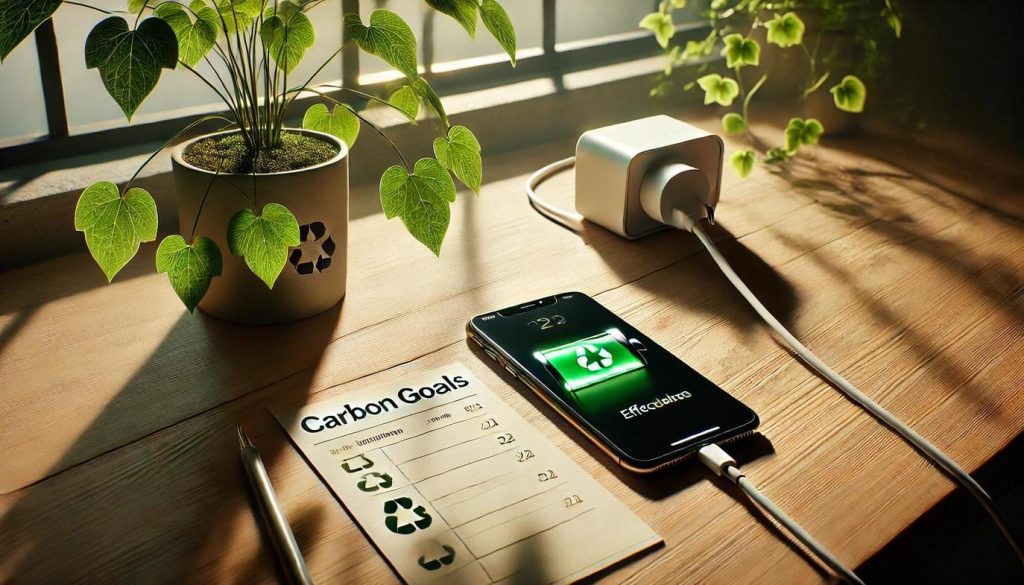
Your iPhone Carbon Footprint FAQ
How much CO₂ does an iPhone produce?
The iPhone 16 emits about 56 kg CO₂e over its lifecycle. Higher-capacity models emit more — for example, the 512GB version produces roughly 74 kg CO₂e.
What’s the biggest source of emissions from an iPhone?
About 80% of emissions occur during production, including chip manufacturing, battery construction, and materials processing.
How can I reduce my iPhone’s environmental impact?
You can reduce emissions by charging only when needed, enabling Low Power Mode, managing background app refresh, and extending your upgrade cycle.
Is Apple carbon neutral yet?
Not yet — but the company’s Apple 2030 plan aims to make its entire carbon footprint, including devices, net zero by 2030.
Does recycling or trading in my iPhone help?
Yes. Apple’s trade-in program refurbishes or recycles old devices. This helps lower the demand for new raw materials and reduces carbon emissions.




